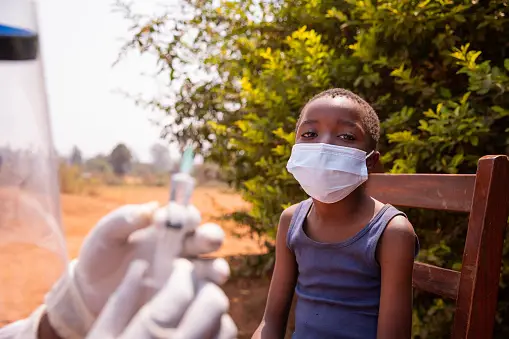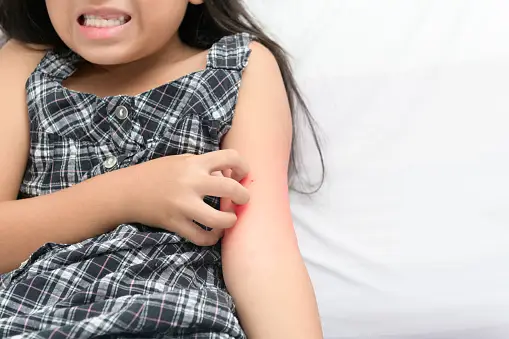Malaria is a life-threatening disease caused by parasites of the genus Plasmodium, transmitted to humans through the bites of infected female Anopheles mosquitoes. Despite significant advances in medical science and public health efforts, malaria remains one of the most pervasive and deadly infectious diseases, particularly affecting tropical and subtropical regions. Each year, it causes hundreds of thousands of deaths, with the majority of victims being children under the age of five in sub-Saharan Africa.
The symptoms of malaria, which include fever, chills, headache, and nausea, can rapidly progress to severe illness and complications such as anemia, cerebral malaria, and multi-organ failure. The fight against malaria involves a combination of preventative measures, such as insecticide-treated mosquito nets and antimalarial medications, as well as efforts to improve diagnosis and treatment. Despite these efforts, the emergence of drug-resistant strains of Plasmodium and insecticide-resistant mosquitoes poses significant challenges. Understanding malaria’s transmission, symptoms, and treatment options is crucial for controlling and ultimately eradicating this devastating disease.
Table of Contents
Symptoms of Malaria

Malaria is characterized by a wide range of symptoms that vary in severity depending on the type of Plasmodium parasite involved, the patient’s immunity, and the timeliness of treatment. Symptoms typically appear 10 to 15 days after being bitten by an infected mosquito but can occur later, especially in those who have taken antimalarial medications. Here are the primary symptoms associated with malaria:
1. Initial Symptoms
- Fever: A high fever is one of the most common and prominent symptoms of malaria. It often follows a cyclical pattern, coinciding with the life cycle of the parasite in the bloodstream.
- Chills: Patients typically experience severe chills and shivering, often accompanied by sweating as the fever breaks.
- Headache: Intense headaches are common and can be persistent.
- Muscle Pain: Muscle and joint pain, often described as flu-like aches, are frequent symptoms.
- Fatigue: Profound fatigue and weakness are typical due to the body’s response to infection and the destruction of red blood cells.
- Nausea and Vomiting: Gastrointestinal symptoms, including nausea and vomiting, are common in many patients.
- Sweating: Profuse sweating often follows episodes of chills and fever.
2. Severe Symptoms
If left untreated, malaria can progress to severe disease, especially in Plasmodium falciparum infections. Severe symptoms include:
- Anemia: Destruction of red blood cells by the parasite leads to severe anemia, characterized by fatigue, pallor, and shortness of breath.
- Jaundice: The breakdown of red blood cells can cause jaundice, where the skin and eyes turn yellow.
- Cerebral Malaria: This is a severe complication where the parasite infects the brain, leading to neurological symptoms such as seizures, confusion, coma, and, potentially, death.
- Respiratory Distress: Difficulty breathing or respiratory distress can occur due to anemia, metabolic acidosis, or acute respiratory distress syndrome (ARDS).
- Organ Failure: Malaria can cause severe complications involving multiple organs, including the kidneys (acute kidney injury), liver (hepatic dysfunction), and the spleen (splenic rupture).
- Hypoglycemia: Low blood sugar levels can occur, particularly in children and pregnant women, exacerbated by the infection and certain antimalarial treatments.
3. Symptoms Based on Parasite Type
- **Plasmodium falciparum: **The most dangerous type, often causing severe disease and the highest risk of complications and death.
- **Plasmodium vivax: **Typically causes recurring fevers every 48 hours and can lead to chronic infections due to dormant liver stages (hypnozoites).
- **Plasmodium ovale: **Similar to P. vivax with recurring fevers and potential for dormant liver stages.
- **Plasmodium malariae: **Characterized by fever episodes every 72 hours and can cause chronic infection, sometimes persisting for decades if untreated.
- **Plasmodium knowlesi: **A parasite of monkeys that can infect humans, leading to daily fever cycles and potential for severe disease.
4. Complications in Vulnerable Groups
- Children: Young children are particularly vulnerable to severe malaria and its complications, including cerebral malaria, severe anemia, and death.
- Pregnant Women: Pregnant women are at higher risk for severe disease, complications like maternal anemia, fetal loss, premature delivery, and low birth weight.
- Travelers: Non-immune travelers to endemic regions are at high risk of severe disease due to lack of acquired immunity.
Early recognition of symptoms and prompt medical treatment are essential for reducing the risk of severe complications and mortality associated with malaria. If malaria is suspected, immediate medical evaluation and diagnostic testing are crucial for initiating appropriate treatment and improving patient outcomes.
Causes of Malaria

Malaria is primarily caused by infection with parasites of the genus Plasmodium, which are transmitted to humans through the bites of infected female Anopheles mosquitoes. Here are the main causes and contributing factors to malaria infection:
1. Plasmodium Parasites
- Species: There are five species of Plasmodium that cause malaria in humans:
- Plasmodium falciparum: The most severe and deadly form, prevalent in sub-Saharan Africa.
- Plasmodium vivax: Known for causing recurrent malaria, prevalent in Asia and Latin America.
- Plasmodium ovale: Similar to P. vivax, found in West Africa and the Pacific Islands.
- Plasmodium malariae: Causes a more chronic form of malaria, found worldwide but less common.
- Plasmodium knowlesi: A parasite of monkeys that can infect humans, found in Southeast Asia.
2. Transmission by Anopheles Mosquitoes
- Mosquito Bites: Malaria is transmitted by the bite of an infected female Anopheles mosquito. The mosquito becomes infected when it bites a person who already has malaria.
- Sporozoites Injection: During a blood meal, the mosquito injects Plasmodium sporozoites into the human bloodstream.
3. Environmental Factors
- Breeding Sites: Anopheles mosquitoes breed in stagnant water. Areas with standing water, such as swamps, marshes, and puddles, provide ideal breeding grounds.
- Climate: Warm and humid climates are conducive to mosquito survival and the lifecycle of Plasmodium parasites, making tropical and subtropical regions high-risk areas.
4. Human Behavior and Practices
- Lack of Protective Measures: Not using mosquito nets, repellents, or protective clothing increases the risk of mosquito bites.
- Outdoor Activities: Spending time outdoors, especially during dusk and dawn when mosquitoes are most active, increases exposure.
5. Socioeconomic Factors
- Access to Healthcare: Limited access to effective antimalarial treatment and preventive measures can lead to higher transmission rates.
- Public Health Infrastructure: Weak public health systems and lack of resources for mosquito control and education can exacerbate the spread of malaria.
6. Travel and Migration
- Travel to Endemic Areas: Travelers from non-endemic regions to malaria-endemic areas are at higher risk due to lack of immunity.
- Population Movement: Migration from or to areas with high malaria transmission can introduce the parasite to new regions or populations.
7. Blood Transfusions and Needle Sharing
- Transfusions: Receiving blood from an infected donor can transmit malaria.
- Needle Sharing: Sharing needles contaminated with infected blood can also transmit the parasite.
8. Congenital Transmission
- Mother to Child: In rare cases, malaria can be transmitted from a pregnant mother to her unborn child.
Understanding these causes is essential for developing effective prevention and control strategies to combat malaria and reduce its incidence and impact globally.
Diagnosis of Malaria

The diagnosis of malaria involves a combination of clinical assessment and laboratory tests to confirm the presence of Plasmodium parasites in the blood. Accurate and timely diagnosis is crucial for effective treatment and management of the disease. Here are the key methods and steps involved in diagnosing malaria:
1. Clinical Assessment
- Patient History: The healthcare provider will take a detailed history, including recent travel to malaria-endemic areas, history of fever, chills, and other symptoms suggestive of malaria.
- Physical Examination: A thorough physical examination is conducted to check for signs of malaria, such as fever, pallor (indicative of anemia), jaundice, and an enlarged spleen or liver.
2. Laboratory Tests
- Microscopic Examination:
- Blood Smear: A blood sample is taken and stained to prepare a blood smear, which is then examined under a microscope to identify the presence of Plasmodium parasites.
- Thick and Thin Smears: Thick smears are used to detect the presence of parasites, while thin smears help in identifying the species of Plasmodium and estimating the level of parasitemia.
- Advantages: Microscopy is highly specific and allows for species identification and parasite density estimation. However, it requires skilled technicians and good-quality equipment.
- Rapid Diagnostic Tests (RDTs):
- Antigen Detection: RDTs detect specific antigens produced by malaria parasites in the blood. These tests are quick, easy to perform, and do not require specialized equipment.
- Types of RDTs: Different RDTs target various antigens, such as histidine-rich protein II (HRP-II) for P. falciparum and lactate dehydrogenase (LDH) for other Plasmodium species.
- Advantages: RDTs provide results within 15-30 minutes and are useful in remote or resource-limited settings. They are less dependent on the skill of the operator compared to microscopy.
- Polymerase Chain Reaction (PCR):
- DNA Detection: PCR tests detect the genetic material of malaria parasites. This method is highly sensitive and specific and can detect low levels of parasitemia and mixed infections.
- Advantages: PCR is useful for confirming diagnosis, especially in cases where microscopy and RDTs are inconclusive. It is also valuable for identifying drug-resistant strains.
- Limitations: PCR requires sophisticated laboratory equipment and trained personnel, making it less accessible in remote or resource-poor areas.
- Serological Tests:
- Antibody Detection: Serological tests detect antibodies produced in response to malaria infection. These tests are not typically used for acute diagnosis but can be helpful in epidemiological studies.
- Limitations: Since antibodies persist after infection, serological tests cannot distinguish between current and past infections.
3. Differential Diagnosis
- Other Causes of Fever: Malaria shares symptoms with many other febrile illnesses, such as dengue, typhoid fever, and influenza. Differential diagnosis is important to rule out these conditions.
- Co-infections: In malaria-endemic areas, co-infections with other diseases like HIV, tuberculosis, or bacterial infections may occur, complicating the clinical picture.
4. Additional Diagnostic Measures
- Complete Blood Count (CBC): A CBC can reveal anemia, thrombocytopenia (low platelet count), and leukocytosis (high white blood cell count), which are common in malaria patients.
- Liver and Kidney Function Tests: These tests help assess the severity of the disease and monitor organ function, especially in severe cases of malaria.
Accurate diagnosis of malaria requires a combination of clinical assessment and laboratory tests. Microscopy and RDTs are the most commonly used methods, with PCR providing additional confirmation and detection of mixed or low-level infections. Timely and precise diagnosis is essential for initiating appropriate treatment, reducing complications, and preventing the spread of malaria.
Treatment of Malaria

Effective treatment of malaria involves the prompt administration of antimalarial medications to clear the Plasmodium parasites from the bloodstream and address symptoms. The choice of treatment depends on the species of Plasmodium, the severity of the disease, the patient’s age, pregnancy status, and any known drug resistance patterns. Here are the key aspects of malaria treatment:
1. Antimalarial Medications
Uncomplicated Malaria:
- Artemisinin-Based Combination Therapies (ACTs):
- Description: ACTs are the first-line treatment for uncomplicated Plasmodium falciparum malaria. They combine an artemisinin derivative with another antimalarial drug to enhance efficacy and reduce the risk of resistance.
- Common ACTs:
- Artemether-lumefantrine (Coartem)
- Artesunate-amodiaquine
- Artesunate-mefloquine
- Dihydroartemisinin-piperaquine
- Artesunate-pyronaridine
- Dosage: ACTs are typically administered orally for three days.
- Chloroquine:
- Description: Used for treating Plasmodium vivax, Plasmodium ovale, and Plasmodium malariae in regions where these species remain sensitive to chloroquine.
- Dosage: Administered orally for three days.
- Primaquine:
- Description: Used to eliminate dormant liver stages (hypnozoites) of P. vivax and P. ovale to prevent relapse.
- Dosage: Administered orally for 14 days, following the initial treatment with chloroquine or an ACT.
- Note: Primaquine requires screening for glucose-6-phosphate dehydrogenase (G6PD) deficiency to avoid hemolysis.
Severe Malaria:
- Intravenous (IV) Artesunate:
- Description: The preferred treatment for severe malaria due to its rapid action and high efficacy.
- Dosage: Administered intravenously, typically for at least 24 hours, followed by a complete course of ACTs.
- Quinine or Quinidine:
- Description: Alternative treatments where IV artesunate is not available. These drugs require close monitoring for side effects.
- Dosage: Administered intravenously, with frequent monitoring for cardiac and blood glucose levels.
- Follow-up Treatment:
- After initial IV therapy, patients switch to oral ACTs to complete the treatment course.
2. Supportive Care
Management of Complications:
- Fluid Management: Careful administration of fluids to maintain hydration without causing fluid overload.
- Antipyretics: Medications such as acetaminophen (paracetamol) to reduce fever and discomfort.
- Blood Transfusion: May be necessary in cases of severe anemia.
- Monitoring and Support: Intensive care monitoring for organ function, especially in severe cases involving the brain, kidneys, or respiratory system.
3. Special Considerations
Pregnancy:
- Treatment Choices: Pregnant women require specific treatment regimens due to the increased risk of complications. Quinine with clindamycin or ACTs are often used, with the choice depending on the trimester and local resistance patterns.
Children:
- Dosing Adjustments: Pediatric doses are carefully calculated based on body weight, with special attention to potential side effects and the need for supportive care.
4. Drug Resistance and Treatment Failures
Resistance Management:
- Monitoring Resistance: Continuous monitoring for drug resistance helps guide treatment choices and policy.
- Alternative Medications: In areas with high resistance to first-line treatments, alternative medications and combination therapies are explored.
5. Preventive Treatments
Intermittent Preventive Treatment (IPT):
- For Pregnant Women (IPTp): Routine administration of antimalarial drugs during pregnancy to prevent malaria.
- For Infants (IPTi): Periodic treatment of infants in high-transmission areas to reduce the incidence of malaria.
The effective treatment of malaria requires a comprehensive approach involving prompt diagnosis, appropriate use of antimalarial medications, and supportive care to manage symptoms and complications. Artemisinin-based combination therapies (ACTs) are the cornerstone of treatment for uncomplicated malaria, while intravenous artesunate is preferred for severe cases. Special considerations are necessary for vulnerable groups such as pregnant women and children. Addressing drug resistance through ongoing monitoring and adapting treatment protocols is essential for maintaining the efficacy of malaria treatment and ultimately reducing the global burden of this life-threatening disease.
How to Prevent Malaria

Preventing malaria involves a combination of personal protective measures, community-wide interventions, and public health strategies aimed at reducing the transmission of Plasmodium parasites by Anopheles mosquitoes. Here are key methods and practices for preventing malaria:
1. Personal Protective Measures
Insecticide-Treated Nets (ITNs):
- Usage: Sleep under ITNs every night, particularly in areas with high malaria transmission.
- Effectiveness: ITNs significantly reduce mosquito bites and are effective for up to three years, depending on the type of insecticide used.
Indoor Residual Spraying (IRS):
- Application: Spraying the inside walls and ceilings of homes with long-lasting insecticides.
- Timing: Typically done once or twice a year, depending on the insecticide and local malaria transmission patterns.
- Effectiveness: IRS kills mosquitoes that rest on treated surfaces, reducing indoor mosquito populations.
Protective Clothing:
- Clothing: Wear long-sleeved shirts, long pants, and socks, especially during peak mosquito activity times (dusk and dawn).
- Colors: Light-colored clothing is preferable, as it is less attractive to mosquitoes.
Insect Repellents:
- Types: Use insect repellents containing DEET, picaridin, IR3535, or oil of lemon eucalyptus on exposed skin and clothing.
- Application: Follow the instructions on the label for safe and effective use.
2. Preventive Medications (Chemoprophylaxis)
For Travelers:
- Prescription: Consult a healthcare provider for appropriate antimalarial medications before traveling to malaria-endemic areas.
- Common Medications:
- Atovaquone-proguanil (Malarone)
- Doxycycline
- Mefloquine (Lariam)
- Chloroquine (in areas with chloroquine-sensitive malaria)
- Duration: Start the medication before travel, continue during the stay, and for a period after leaving the area (depending on the drug used).
Intermittent Preventive Treatment (IPT):
- For Pregnant Women (IPTp): Regular administration of antimalarial drugs during pregnancy to reduce the risk of malaria for both the mother and the unborn child.
- For Infants (IPTi): Periodic treatment of infants in high-transmission areas to prevent malaria and reduce its incidence.
3. Community-Wide Interventions
Environmental Management:
- Breeding Site Reduction: Eliminate stagnant water where mosquitoes breed by draining swamps, filling puddles, and improving water management.
- Sanitation: Maintain clean surroundings to reduce mosquito breeding sites.
Larval Control:
- Larvicides: Apply chemical or biological agents to water sources to kill mosquito larvae.
- Biological Control: Introduce natural predators of mosquito larvae, such as certain fish species, to breeding sites.
4. Public Health Strategies
Surveillance and Rapid Response:
- Monitoring: Regular monitoring of malaria cases to detect outbreaks early and respond quickly.
- Outbreak Control: Implement targeted IRS and ITN distribution in response to outbreaks.
Health Education:
- Community Awareness: Educate communities about malaria prevention methods, symptoms, and the importance of seeking prompt treatment.
- School Programs: Implement educational programs in schools to teach children about malaria prevention.
Research and Development:
- Vaccine Development: Support the development and deployment of malaria vaccines, such as the RTS,S/AS01 (Mosquirix) vaccine.
- Drug Development: Encourage research into new antimalarial drugs to combat drug resistance.
Preventing malaria requires a multifaceted approach involving personal protective measures, community interventions, and robust public health strategies. By using insecticide-treated nets, indoor residual spraying, protective clothing, insect repellents, and preventive medications, individuals can significantly reduce their risk of malaria. Community-wide efforts, such as environmental management, larval control, and health education, further support these measures. Ongoing research and development in vaccines and antimalarial drugs are essential for sustaining progress in malaria prevention and ultimately achieving the goal of malaria eradication.
Complications of Malaria

Malaria can lead to a range of severe and potentially life-threatening complications, particularly if it is caused by Plasmodium falciparum and is not promptly and effectively treated. Here are some of the major complications associated with malaria:
1. Cerebral Malaria
- Description: A severe neurological complication characterized by high fever, seizures, and loss of consciousness.
- Mechanism: Parasite-infected red blood cells obstruct blood flow to the brain, leading to inflammation and brain damage.
- Symptoms: Altered mental status, seizures, coma, and neurological deficits.
- Outcome: If untreated, cerebral malaria can be fatal or result in long-term neurological impairments.
2. Severe Anemia
- Description: A significant reduction in red blood cell count due to the destruction of infected and uninfected red blood cells.
- Mechanism: The malaria parasite invades and destroys red blood cells, leading to hemolysis and reduced oxygen-carrying capacity.
- Symptoms: Fatigue, pallor, shortness of breath, and rapid heart rate.
- Outcome: Severe anemia can lead to heart failure and other complications, particularly in children and pregnant women.
3. Acute Respiratory Distress Syndrome (ARDS)
- Description: A severe lung condition that causes difficulty breathing and inadequate oxygenation of the blood.
- Mechanism: Inflammation and fluid accumulation in the lungs due to the immune response to malaria infection.
- Symptoms: Rapid breathing, shortness of breath, and low oxygen levels.
- Outcome: ARDS requires intensive medical care and can be fatal if not treated promptly.
4. Hypoglycemia
- Description: Abnormally low blood glucose levels, often seen in severe malaria and during treatment with quinine.
- Mechanism: The parasites consume glucose, and some antimalarial medications stimulate insulin release.
- Symptoms: Sweating, confusion, seizures, and loss of consciousness.
- Outcome: Severe hypoglycemia can lead to coma and death if not quickly corrected.
5. Metabolic Acidosis
- Description: An accumulation of acid in the body due to the breakdown of red blood cells and impaired kidney function.
- Mechanism: Increased lactate production from anaerobic metabolism and reduced kidney function.
- Symptoms: Rapid breathing, confusion, lethargy, and shock.
- Outcome: Metabolic acidosis is a critical condition that can lead to multiple organ failure and death.
6. Kidney Failure (Acute Renal Failure)
- Description: A sudden loss of kidney function, which can result in the inability to remove waste products and balance fluids.
- Mechanism: Blockage of small blood vessels in the kidneys by infected red blood cells.
- Symptoms: Reduced urine output, swelling, fatigue, and confusion.
- Outcome: Requires dialysis and intensive care; can be fatal if untreated.
7. Splenic Rupture
- Description: An uncommon but serious complication where the spleen becomes enlarged and ruptures.
- Mechanism: The spleen filters infected red blood cells and can become overworked and swollen.
- Symptoms: Sudden severe abdominal pain, low blood pressure, and shock.
- Outcome: A ruptured spleen is a medical emergency requiring immediate surgery.
8. Jaundice and Liver Failure
- Description: Yellowing of the skin and eyes due to high levels of bilirubin in the blood.
- Mechanism: Destruction of red blood cells releases bilirubin, and liver dysfunction impairs its clearance.
- Symptoms: Yellow skin and eyes, dark urine, and abdominal pain.
- Outcome: Severe liver involvement can lead to liver failure and requires intensive care.
9. Severe Dehydration
- Description: Excessive fluid loss due to high fever, sweating, and vomiting.
- Mechanism: Fluid loss exceeds intake, leading to dehydration.
- Symptoms: Dry mouth, decreased urine output, and rapid heart rate.
- Outcome: Severe dehydration can lead to shock and organ failure if not promptly managed.
Malaria, particularly when caused by Plasmodium falciparum, can lead to severe and life-threatening complications affecting various organs and systems in the body. Prompt diagnosis and effective treatment are crucial to prevent these complications and reduce the risk of death. Understanding the potential complications of malaria emphasizes the importance of prevention, early detection, and comprehensive management of this disease to minimize its impact on individuals and communities.
Living with Malaria

Living with malaria involves managing symptoms, adhering to treatment regimens, and taking preventive measures to avoid recurrence or complications. Here are some key considerations and strategies for individuals living with malaria:
1. Adherence to Treatment
Medication Compliance:
- Complete the Course: It is crucial to complete the full course of prescribed antimalarial medication, even if symptoms improve, to ensure the parasite is fully eradicated.
- Follow Instructions: Take medications exactly as directed by the healthcare provider, paying attention to dosages and timing.
Monitoring Side Effects:
- Common Side Effects: Be aware of possible side effects from antimalarial drugs, such as nausea, dizziness, or headaches, and report any severe or persistent symptoms to a healthcare provider.
- Regular Check-ups: Attend follow-up appointments to monitor the effectiveness of the treatment and check for potential complications.
2. Symptom Management
Managing Fever and Pain:
- Antipyretics: Use over-the-counter medications like acetaminophen (paracetamol) to reduce fever and alleviate pain.
- Hydration: Stay well-hydrated by drinking plenty of fluids to help manage fever and prevent dehydration.
- Adequate Rest: Get plenty of rest to help the body recover from the infection.
- Balanced Diet: Eat a nutritious diet to support immune function and overall health.
3. Preventing Recurrence
Avoiding Re-infection:
- Insecticide-Treated Nets (ITNs): Continue using ITNs to prevent mosquito bites during sleep.
- Insect Repellents: Apply insect repellents to exposed skin and clothing, especially during peak mosquito activity times (dusk and dawn).
- Protective Clothing: Wear long-sleeved shirts, long pants, and socks to reduce skin exposure.
Environmental Measures:
- Eliminate Breeding Sites: Remove standing water around the home where mosquitoes can breed, such as puddles, buckets, and other containers.
- Indoor Residual Spraying (IRS): Ensure that the interior of the home is treated with insecticides if living in a high-risk area.
4. Long-Term Health Management
Regular Medical Check-ups:
- Monitor Health: Regularly visit a healthcare provider to monitor for any long-term effects of malaria, such as anemia or organ damage.
- Blood Tests: Periodic blood tests may be necessary to ensure that the malaria parasites have been completely eradicated.
Managing Chronic Complications:
- Address Anemia: If malaria has caused anemia, follow medical advice on managing this condition, which may include dietary changes or supplements.
- Liver and Kidney Health: Monitor liver and kidney function, especially if these organs were affected during the malaria infection.
5. Psychosocial Support
- Coping with Anxiety: Living with a recurrent or severe illness like malaria can be stressful. Seek support from mental health professionals if experiencing anxiety or depression.
- Support Groups: Join support groups or communities of others who have experienced malaria to share experiences and gain emotional support.
6. Education and Awareness
Understanding Malaria:
- Know the Disease: Educate yourself about malaria, its symptoms, and how it is transmitted to better manage the condition and prevent future infections.
- Stay Informed: Keep up-to-date with information from healthcare providers and public health organizations regarding malaria prevention and treatment.
Community Involvement:
- Spread Awareness: Educate others in your community about malaria prevention and the importance of seeking prompt treatment.
- Support Public Health Initiatives: Participate in community efforts to reduce mosquito populations and improve public health infrastructure.
Living with malaria requires a proactive approach to treatment, symptom management, and prevention. By adhering to medication regimens, managing symptoms, and taking steps to prevent re-infection, individuals can effectively manage their health and reduce the impact of malaria on their daily lives. Regular medical check-ups and a supportive environment are also essential for long-term well-being. Understanding and addressing the psychosocial aspects of living with malaria can further enhance quality of life for those affected by this disease.
Conclusion
In conclusion, malaria remains a significant global health challenge, particularly in tropical and subtropical regions where Plasmodium parasites and their mosquito vectors thrive. This disease affects millions of people each year, causing substantial morbidity and mortality, especially among vulnerable populations such as children and pregnant women.
Throughout this exploration, we’ve delved into various aspects of malaria: its causes, symptoms, diagnosis, treatment, prevention strategies, complications, and the practical considerations of living with the disease. Understanding these facets is crucial for both individuals and communities in combating malaria effectively.
Prevention remains the cornerstone of malaria control efforts, encompassing measures like the use of insecticide-treated nets, indoor residual spraying, and chemoprophylaxis for travelers. Early diagnosis and prompt treatment with appropriate antimalarial medications are vital to preventing severe complications and reducing mortality rates.
For those living with malaria, adherence to treatment regimens, management of symptoms, and ongoing preventive measures are essential to maintain health and minimize the risk of recurrence. Long-term health management involves regular medical check-ups, addressing any chronic complications, and staying informed about advancements in malaria research and treatment.
Efforts to combat malaria also extend to public health initiatives, including surveillance, vector control programs, and community education to raise awareness and promote preventive behaviors. Collaborative efforts among governments, healthcare providers, researchers, and communities are crucial in achieving the goal of malaria elimination and ultimately reducing the global burden of this disease.
By fostering continued innovation, investment in healthcare infrastructure, and fostering community engagement, we can strive towards a future where malaria no longer poses a significant threat to public health worldwide. Together, through sustained commitment and collective action, we can work towards a malaria-free world.
